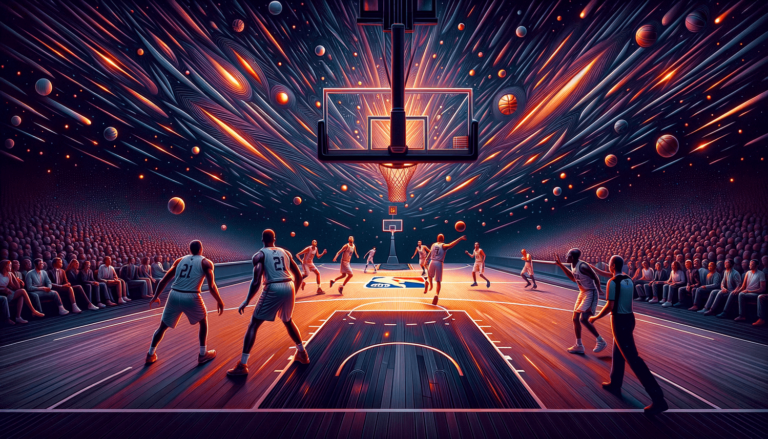
NBA’s Technical Foul Points System: Explained
Written by: Basketball Universe
Last updated:

In the thrilling world of NBA basketball, there’s much more to the game than just fast breaks and slam dunks. A crucial, yet often overlooked component of the sport is the enigmatic technical foul points system. If you’ve ever found yourself scratching your head and wondering how this complex system truly functions, this blog post is your one-stop-shop for unraveling the mystery. With an intriguing blend of rules, fines, and far-reaching consequences, the NBA’s technical foul points system adds a fascinating layer of strategy and intrigue to the game we all love. So let’s dive into the nitty-gritty and, together, deconstruct this riveting aspect of professional basketball!
NBA’s Technical Foul Points System: Explained
The NBA’s technical foul points system imposes penalties on players and coaches for actions deemed unsportsmanlike or detrimental to the game. Once a player accumulates 16 technical fouls in a regular season, they receive a one-game suspension, with an additional one-game suspension for every two subsequent technical fouls. In the playoffs, a player is suspended for one game after receiving seven technical fouls, and for each two additional fouls thereafter. Coaches, however, may receive an unlimited number of technical fouls without suspension, but they are subject to league fines.
Decoding Technical Fouls: The Basics
Before we can delve into the intricacies of the NBA’s technical foul points system, it’s essential to understand the basics of what constitutes a technical foul. In the realm of basketball rules, technical fouls are infractions that occur outside the realm of standard gameplay, and they’re typically related to issues of unsportsmanlike conduct or other rule violations that disrupt the smooth flow of the game. Examples of such fouls include arguing with the referees, excessive taunting, or delay of game.
How the Points System works: Step by Step
The points system revolves around tallying up technical fouls accumulated by players and coaches throughout the season. Let’s unravel how it operates, step by step:
1. Accumulating Technical Fouls
Players and coaches both accumulate technical fouls throughout the regular season and playoffs. Each technical foul incurred is added to their personal count.
2. Reaching Key Milestones
For players, once they reach certain milestones, they will face suspensions and other consequences. These milestones are as follows:
- 16 technical fouls in the regular season: One-game suspension without pay.
- Every additional two technical fouls in the regular season: One additional game suspension without pay (e.g., 18 fouls = an extra suspension).
- Seven technical fouls in the playoffs: One-game suspension without pay.
- Every additional two technical fouls in the playoffs: One additional game suspension without pay (e.g., 9 fouls = an extra suspension).
Coaches, however, can receive an unlimited number of technical fouls without being suspended, though they will be subject to fines from the league.
3. Paying Fines
Along with the game suspensions, players and coaches are subject to specific fines for every technical foul they receive. The fine amounts increase as the number of technical fouls grows throughout the season, both in the regular season and playoffs. The NBA is strict when it comes to these fines to discourage inappropriate behavior.
The Criteria for Issuing Technical Fouls
It’s important to recognize the actions that may result in a technical foul being called. A deeper appreciation of the criteria can shed further light on the point system and how it can influence players’ behavior throughout a season.
1. Verbal Misconduct
When players and coaches use language that is deemed offensive or unsportsmanlike, it results in a technical foul call. This may include excessive complaining, directing profanity at the referees, or taunting opponents.
2. Physical Misconduct
Any physical behavior towards referees, opposing team’s players, or coaches that is deemed aggressive, provocative, and unsportsmanlike will result in a technical foul. This may include actions like confronting a referee, shoving an opponent, or excessive physical contact after the whistle has blown.
3. Delay of Game
Intentionally delaying the game can lead to a technical foul call. Some examples include purposely taking too long to inbound the ball, not properly lining up for free throws, or intentionally knocking the ball into the stands after a call has been made.
4. Hanging on the Rim
Players who unnecessarily hang on the rim for an extended period after a dunk can be slapped with a technical foul, as this action can disrupt game flow and potentially even provoke opponents.
5. Flopping
Flopping, which refers to acting as though significant contact occurred with the intention of drawing a foul, can also result in a technical foul if the referee believes the player deliberately exaggerated the reaction.
6. Violating the 20-second Huddle Rule
Following free throws and other stoppages in play, teams must break their huddles within 20 seconds. If referees determine that a team is intentionally taking more than the allotted time in an attempt to delay the game, a technical foul can be issued.
Technical Fouls: The Coaches’ Perspective
Though players often receive more focus, coaches also play a significant role in the NBA’s technical foul points system. It’s essential to understand their part in the process and any differences between technical fouls assigned to players and coaches.
1. No Suspension Limitations
One crucial difference between players and coaches is that coaches are not subject to suspensions based on a specific number of technical fouls. This is because a coach’s ability to manage the team during the game is a vital element of the sport, and removing them from their job entirely for an extended period could have unintended, negative consequences on the overall competitiveness of the league.
2. Fines still Apply
That being said, coaches are still subject to fines for every technical foul they accumulate. This helps deter unwanted behavior while ensuring that the game’s integrity remains intact.
3. Influence on Players
Coaches also play a critical role in guiding their players’ behavior, as they can set the tone for the team’s temperament and, in turn, their likelihood of drawing technical fouls. A coach who can keep their players level-headed and in control can often prevent unnecessary technical fouls from influencing the outcome of a game.
History of Noteworthy Technical Fouls and Suspensions
Given the high stakes attached to technical fouls, it’s unsurprising that there have been some memorable instances throughout NBA history. These moments have served as crucial learning experiences for players and coaches while showcasing the importance of the NBA’s technical foul points system.
Rasheed Wallace: The Record-Holder
Rasheed Wallace, a retired player who spent a significant part of his career with the Portland Trail Blazers and Detroit Pistons, holds the record for the most technical fouls in a single season with a staggering 41 fouls in the 2000-01 regular season. Wallace’s penchant for accumulating technical fouls led to numerous suspensions throughout his career.
Draymond Green: Costly Technical Foul in the 2016 Playoffs
During the 2016 NBA Playoffs, Draymond Green of the Golden State Warriors infamously received a one-game suspension for accumulating too many flagrant foul points, which included some technical fouls as well. Green’s suspension significantly impacted the Warriors as they went on to lose the NBA Finals to the Cleveland Cavaliers. This serves as a prime example of how critical managing technical fouls can be, as a single suspension can have far-reaching consequences for an entire team.
The Strategic Side of Technical Fouls
Though often viewed negatively, technical fouls can also be wielded strategically by both players and coaches. When used carefully, certain actions might be perceived as intentional provocation in order to encourage an opposing player to receive a technical foul, following which their team will be given a free throw and possession of the ball.
It’s a delicate balancing act, as deliberately trying to draw technical fouls by engaging in unsportsmanlike behavior can backfire and result in a technical foul for the provocateur instead. But in high-stakes situations and games where every point counts, some players and coaches may feel it’s worth the risk.
As shown, the NBA’s technical foul points system is not merely a rigid set of rules but a dynamic element of the game that can have major influences on games and even entire seasons. Understanding its intricacies can provide basketball fans and professionals alike a deeper appreciation for the strategic and psychological aspects of this beloved sport.
Impact of Technical Fouls on Team Dynamic and Performance
Technical fouls can have both immediate and long-lasting effects on a team’s performance, morale, and overall dynamic. Understanding these ramifications can help illustrate the importance of the NBA’s technical foul points system and how it acts as a force for maintaining a high level of sportsmanship, respect, and professionalism.
1. Immediate Consequences: Free Throws and Possession
When a technical foul is assessed, the opposing team is awarded one free throw, and in some cases, possession of the ball. This immediate consequence can swing the momentum in the opposing team’s favor, even turning the tide of a closely contested game. Players and coaches must always be mindful of the potential negative impact of their actions on their team’s chances of winning.
2. Team Morale: The Ripple Effect
An accumulation of technical fouls can create tension within the team, causing dissension among teammates and undermining overall team chemistry. The resulting lack of team synergy can severely affect the team’s performance on the court, diminishing their chances of success.
3. Reputational Damage
Repeated technical fouls can harm the reputation of the individual player, the coaching staff, and the team as a whole. Players may become known for their short tempers or unsportsmanlike conduct, which can affect contract negotiations, fan support, and even possible endorsement deals.
Managing Technical Fouls: Tips for Players and Coaches
Both players and coaches can take proactive steps to manage and reduce technical fouls, fostering better teamwork and improved performance. Here are a few key strategies to help navigate the NBA’s technical foul points system most effectively:
1. Keeping a Cool Head
Players and coaches should focus on maintaining emotional control during games, even in high-pressure situations. Frustration is a natural part of competition, but by developing strong coping mechanisms and staying level-headed, they can avoid unnecessary technical fouls.
2. Communication is Key
Open and honest communication between players and coaching staff can help address issues related to technical fouls, including strategies to prevent them. Team leaders should make an effort to create an environment where everyone feels comfortable discussing any issues they might be facing on and off the court.
3. Know the Rules
Having a deep understanding of basketball rules, including those surrounding the NBA’s technical foul points system, is essential for both players and coaches. By knowing the expected standards of conduct and the consequences of any violations, they can better avoid actions that might lead to technical fouls being assessed against them.
4. Learn from Past Mistakes
When a technical foul does occur, both the individual involved and the team as a whole should use it as a learning opportunity. By dissecting the situation, examining the triggers that led to the foul, and discussing ways to avoid future occurrences, the team can work together to ensure that mistakes are not repeated.
Understanding the NBA’s technical foul points system and managing technical fouls effectively are key components of maintaining the sport’s integrity, competitiveness, and professionalism. By appreciating the impacts of technical fouls and adopting strategies to prevent them, players, coaches, and teams can strive for both individual and collective success on the court.
Frequently Asked Questions (FAQ) About NBA’s Technical Foul Points System
With the NBA’s technical foul points system serving as an essential component of the professional basketball landscape, it’s only natural that fans and newcomers to the sport might have questions about how it all works. Here, we’ve compiled a list of ten frequently asked questions and precise answers to help you further bolster your knowledge of this intriguing aspect of the game.
1. What is the purpose of the NBA’s technical foul points system?
The primary purpose of the NBA’s technical foul points system is to ensure that players and coaches maintain a high level of sportsmanship, professionalism, and respect throughout the season. The system penalizes unsportsmanlike conduct or other rule violations with fines and suspensions, thereby discouraging inappropriate behavior and maintaining the integrity of the game.
2. Is the NBA’s technical foul points system the same in every league?
No, the technical foul points system is specific to the NBA and may not be the same in other basketball leagues. Different leagues or associations may have varying rules and regulations regarding technical fouls, depending on their specific requirements and objectives.
3. Are technical fouls issued only to players?
No, technical fouls can be issued to both players and coaches for actions that are considered detrimental to the game, such as arguing with referees, excessive taunting, or intentionally delaying the game. For coaches, there is no suspension limit based on technical fouls, though fines are applicable.
4. How many technical fouls lead to a suspension?
For players, the accumulation of 16 technical fouls during the regular season results in a one-game suspension. After reaching 16, every additional two technical fouls incurred will result in an additional one-game suspension. In the playoffs, a player is suspended for one game after receiving seven technical fouls, and for each two additional fouls thereafter.
5. Are technical fouls wiped clean between the regular season and playoffs?
Yes, technical fouls accumulated during the regular season do not carry over to the playoffs. The count starts anew once the playoffs begin, and any penalties incurred during the regular season are not applicable during the playoff games.
6. Can a player receive more than one technical foul in a single game?
Yes, a player can receive more than one technical foul in a single game. However, if a player receives two technical fouls in a single game, they will be ejected from that game and may face additional penalties, such as fines or suspensions, depending on the specifics of the incident and their past history with technical fouls.
7. What happens if a player is ejected from a game due to technical fouls?
If a player is ejected from a game as a result of receiving two technical fouls, they must leave the court immediately and may not return until the game is over. The opposing team is awarded one free throw for each technical foul, and depending on the specifics of the incident, the player may face additional fines or suspensions.
8. How is a technical foul different from a flagrant foul?
While both technical and flagrant fouls involve penalties, they address different types of violations. A technical foul is typically issued for unsportsmanlike behavior, whereas a flagrant foul involves excessive or malicious contact during play. The punishments for flagrant fouls often include ejections, suspensions, and fines, depending on the severity of the violation.
9. Can a player be given both a technical foul and a flagrant foul on the same play?
Yes, it is possible for a player to receive both a technical and a flagrant foul on the same play, depending on the specific circumstances. For example, a player who commits a flagrant foul, followed by unsportsmanlike behavior, such as arguing with the referees, may be assessed both types of fouls.
10. Do technical fouls impact a player’s chances of winning awards, such as MVP or All-Star selection?
While technical fouls may not directly impact a player’s chances of being selected for awards or All-Star teams, the consequences of accumulating technical fouls, such as suspensions and negative perceptions, can indirectly affect a player’s ability to perform at a high level or be recognized for their contributions on the court.
Featured Posts
- No pillar pages found.





